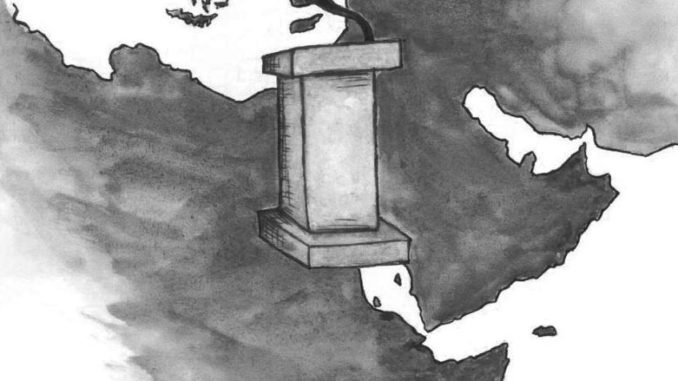
By Abdulrahman Al Rayyis
The Persians and Arabs have a brutal and bloody history of conflicts dating back to 2700 B.C.
The current conflict between the Arabs and Persians is between Iran and Saudi Arabia in their ongoing struggle to dominate the Middle East through proxy wars. Many of these proxy wars resemble those of the Cold War between the United States and the Soviet Union. This struggle is of a political, economic and religious nature. The religious difference in particular makes the conflict especially sensitive. The Iranians are from the Shiite sect of Islam, while the Saudi Arabians are from the Sunni sect. Most of the Muslim world is Sunni, leaving the periphery of the Middle East as a stronghold for Shiites, as seen in Persia. The conflict between Iran and Saudi Arabia intensified after the fall of Saddam Hussein, who acted as a buffer between the two sects.
Once the third Arab awakening occurred in 2011 — the Arab Spring — both the Saudi and Iranian governments felt extremely anxious about these revolutions. Both feared revolution in their own countries and an influx of hostile administrations governing former allies.
The overall effect of this conflict on the Middle East has been negative. It has hindered the development of several democracies in the region and exhausted the economies of many countries. In addition, the two powers are not ready to lead the Middle East; both are facing domestic issues and increasing opposition from the youth who are starting to demand basic rights such as freedom of speech, voting and women’s rights.
Recent protests in Iran and the lifting of restrictions in Saudi Arabia mark a new beginning of an expanding movement of women’s rights in both countries, who are now, ironically, competing to advance women’s rights out of fear of domestic protests. It is no secret that both governments are well aware of the effects of globalization on their youth, and if they do not respond quickly to the demands for increased freedom from strict laws, the consequences might be as heavy as regime change.
The consequences of protests have already affected Iran and its crumbling currency. The current pattern of events shows Saudi dominance inspired by a polarizing American foreign policy. A marginalized Iran might be pushed to take more extreme measures such as engaging in a full-scale war with Saudi Arabia, which raises concerns over chemical and nuclear warfare. Such a war would create a refugee crisis that the region simply cannot afford. However, the risk of an all-out war remains slim due to the mutually destructive nature of this conflict.
One key player in this conflict is the United States, who chose to be a closer ally to Saudi Arabia for two reasons: tolerance of Israel and a steady exchange of cash and weapons. On the other hand, Iran chose to be aggressive toward Israel. In the past, the West labeled the extremism of Arab states based on their tolerance of Israel.
President Trump’s policy in the region included making Saudi Arabia a closer ally through arms deals and marking Iran an enemy with the termination of the nuclear deal. This one-sided policy has pushed Saudi Arabia to play a more aggressive role in the region. Saudi Arabia has grown to be the bully of the region, which is creating resentment against the Saudis in many other Arab states. This resentment is created by a belief that Saudi Arabia is disturbing the domestic politics of its neighbors. Meanwhile, Iran, who has been acting as the opposition, is trying to win over the Arab population with anti-Israel rhetoric. However, the actions of both countries remain damaging to most, if not all countries in the Middle East.
The Middle East remains a widely misunderstood region which makes the discussion of these issues important. It is especially relevant to American students as the American government is heavily involved in Middle East. It is important for the American youth to understand the consequences of the western intervention in Middle East and look at examples to where the American taxpayer money is landing.
Subscribe to the Mossy Log Newsletter
Stay up to date with the goings-on at Lewis & Clark! Get the top stories or your favorite section delivered to your inbox whenever we release a new issue.

Fascinating read Abdulrahman